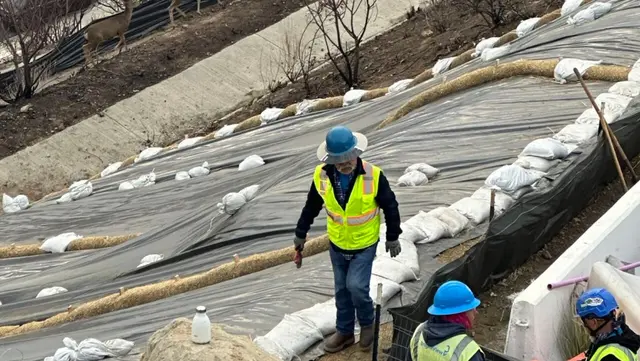
Top Drought Tolerant Plants for California
Tree, shrub, groundcover selections to make the make the most of any California based landscaping project
Landscapers are increasingly turning to drought-tolerant landscaping as a way to preserve resources and save costs. With the increasing frequency of wildfires in California, the need to conserve water is even more critical. Here is a list of some top choices for drought-tolerant trees and shrubs for Northern and Southern California for front yard landscaping, public areas, and landscaping for graded/sloped areas.
Top Drought-Tolerant Plants for Front Yard Landscaping in California
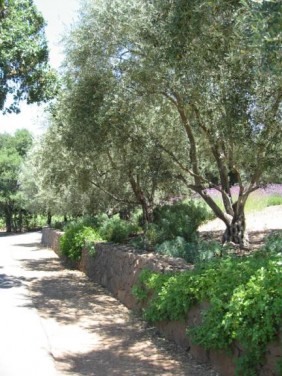
There are a few basic things to consider when selecting plants for the front yard:
- Choose plants that stay contained and compact; unwieldy and woody plants make a yard feel small and less tidy.
- Go for plants that will please year-round, such as evergreens or deciduous plants and trees with good branching structures.
- Consider varied texture and color. Mix grass and agave (fine vs. bold) or blend green and variegated plants.
- Go with plants that echo the architecture, i.e. Spanish vs. Cottage.
Northern California
Trees
- Redbud: This thrifty water-user produces brilliant spring blossoms.
- Tabebuia: Sometimes called pink or golden trumpet trees because of its trumpet-shaped blossoms.
- Arbutus 'marina:' This is a broadleaf evergreen tree which requires minimal care.
Shrubs and Groundcover
- Myoporum 'pink' (as a lawn substitute): This is a deer-resistant groundcover which grows in sun or shade and produces tiny, pink flowers in the summer.
- Callistemon 'Little John:' A mid-sized, red flowering evergreen shrub.
- Coffeeberry: Member of the buckthorn family with shiny, dark leaves and reddish berries.
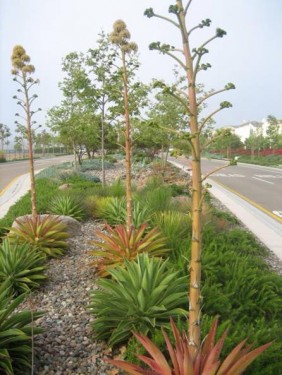
Southern California
Trees
- Olea 'wilsonii:' This is a fruitless olive tree with no mess.
- Carolina laurel: Producing deep green foliage, this is a spring-flowering tree.
- Rhus lancea: Commonly called African sumac, its an evergreen with sword-shaped leaves.
Shrubs and Groundcover
- Sedges and Salvias: These both add color to the landscape and are pollinators.
- Agave: Tough-as-nails and adds nice texture and contrast.
- Dymondia (as a lawn substitute): This groundcover, often refered to as mini-gazania, grows flat to the ground.
Top Drought-Tolerant Plants for Public Space Landscaping in California
It goes without saying that public space landscapes need to be hardy, but these spaces also need to be an attractive visual endorsement for the commercial or pubic property they surround. Public space landscaping also requires higher maintenance, so keep these things in mind:
- Choose plants which can withstand heavy traffic.
- Consider the plant's year-round appeal.
- Select plants with high visual interest; plants with showy foliage, such as succulents and purple grasses, or plants with showy bark, such as Manzanitas and Arbutus.
Northern California
Trees
- Desert Willow: Called a "willow" because of the shape of the leaves. It is related to the Catalpa.
- Acacia aneura: This tree is commonly known as "mulga," or "true mulga."
- Citrus: These trees take a lot of specific nutrients, but not a lot of water.
Shrubs and Groundcover
- Lamb's Ears: This plant is soft and velvety in texture and deer-resistant.
- Groundcover roses: Baby Blanket or the ever-hardy White Meidiland are great groundcover options.
- Bioswale plants such as Juncus and Carex: Perfect for use in low points within the landscape to help clean the rain runoff before it enters streams and the ocean.
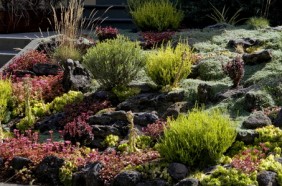
Southern California
Trees
- California Bay: These large hardwood trees native to California's coastal forests.
- Catalina Cherry: Evergreen that produces red berries and showy, white flowers in the spring.
- Crape Myrtle: Blooming mid- to late summer, this tree comes in various shades of pink.
Shrubs and Groundcover
- Ribes: The genus contains about 150 species, several of which are native to California.
- Achillea: Also known as yarrow, legend has it that it was gifted to the war hero, Achilles, by the Olympian gods to help quell the bleeding of his soldiers during the Trojan War.
- Fremontodendron: Best time to plant is late autumn.
Top Drought-Tolerant Plants for Graded/Slope Landscaping in California
Most of the remaining developable land in California is located on hillsides and landscaping such sites takes careful consideration. In addition, much of this land borders natural open spaces, so planting native allows the area to regenerate and flow seamlessly into neighboring areas while also conserving valuable water resources. Think about these basic factors when developing graded landscapes or slopes:
- If exposure to wildfires is an issue, plant the most fire-resistant plants closest to structures and emanate outward.
- If possible, convert the area back to native plants. It saves money, water, and the maintenance associated with more exotic landscapes.
- Think about tighter spacing and more showy plants to enhance trail edges and parkways.
Northern California
Trees
- Oaks: Valley Oaks and Coast Live Oaks are able to withstand the long, dry summers of California. It is best to plant oaks young as any major change in its environment can weaken or kill it, no matter how healthy it is.
- Redwoods: A California icon, it is adaptable to most soil conditions. Word to the wise: these are very fast-growing trees, so plant with that in mind.
- California Christmas Tree: Also known as Deodar Cedar. Allow plenty of room around these fast-growing trees to best display its stately shape.
Shrubs and Groundcover
- Ceanothus: This plant composes about 50 to 60 species. Try Ceanothus Yankee point and Concha.
- Manzanitas: There are lots of varieties of these shrubs that work well in cooler climates.
- Echium: "Pride of Madera" is the common name. This plant is very showy and tough.
- Encelia californica: This shrub is commonly referred to as "California bush sunflower."
Southern California
Trees
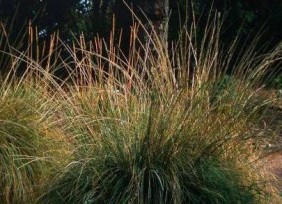
- Native Walnut varieties: Juglans nigra, also known as Black Walnut, originated in Persia, but thrive in Southern California's dry conditions.
- Oaks: There are over 20 species of native California oaks, from shrubby species which only grow a few feet to the mighty oak trees. Many species of native oaks are not regenerating adequately in California, which in turn threatens the oak forests themselves and the wildlife that use them as resources.
- Sycamore (plant at base of slopes): This is one of the largest hardwood trees. It's great for shade.
Shrubs and Groundcover
- Baccharis: This plant is in the aster family It is sometimes referred to as "brooms" because of the plant's small, thin leaves.
- Acacia: Named by Swedish botanist Carl Linnaeus after the African species Acacia nilotica.
- Yucca or Opuntias: These are great for adding focal points and sculptural shapes.
- Deer Grass: Grows in dense clumps with spiky flower stalks and creates striking forms in a landscape.
Great Service, Beautiful Landscapes
Benefit from a comprehensive landscape maintenance plan designed to meet your needs and exceed your expectations, all delivered by a team invested in your success.

